Cardiac Chest Pain: Assessment and Clinical Interventions Report
VerifiedAdded on 2022/08/19
|5
|994
|16
Report
AI Summary
This report focuses on the comprehensive assessment and clinical interventions for cardiac chest pain. It begins with a discussion on differentiating pain quality, location, radiation, and timing to distinguish cardiac chest pain from other sources. The report then outlines the necessary assessments, including echocardiograms and blood tests for cardiac enzymes like troponin. It details diagnostic criteria, such as elevated cardiac enzymes and family history, followed by treatment strategies that include nitroglycerin, CPR, statins, and surgical interventions. A case experience of a 50-year-old woman with chest pain is used to illustrate the importance of thorough medical history and cardiovascular assessments. The report concludes with a recommendation for family nurse practitioners to engage in comprehensive assessments for accurate diagnosis and effective patient care. The paper references several studies that support the findings.
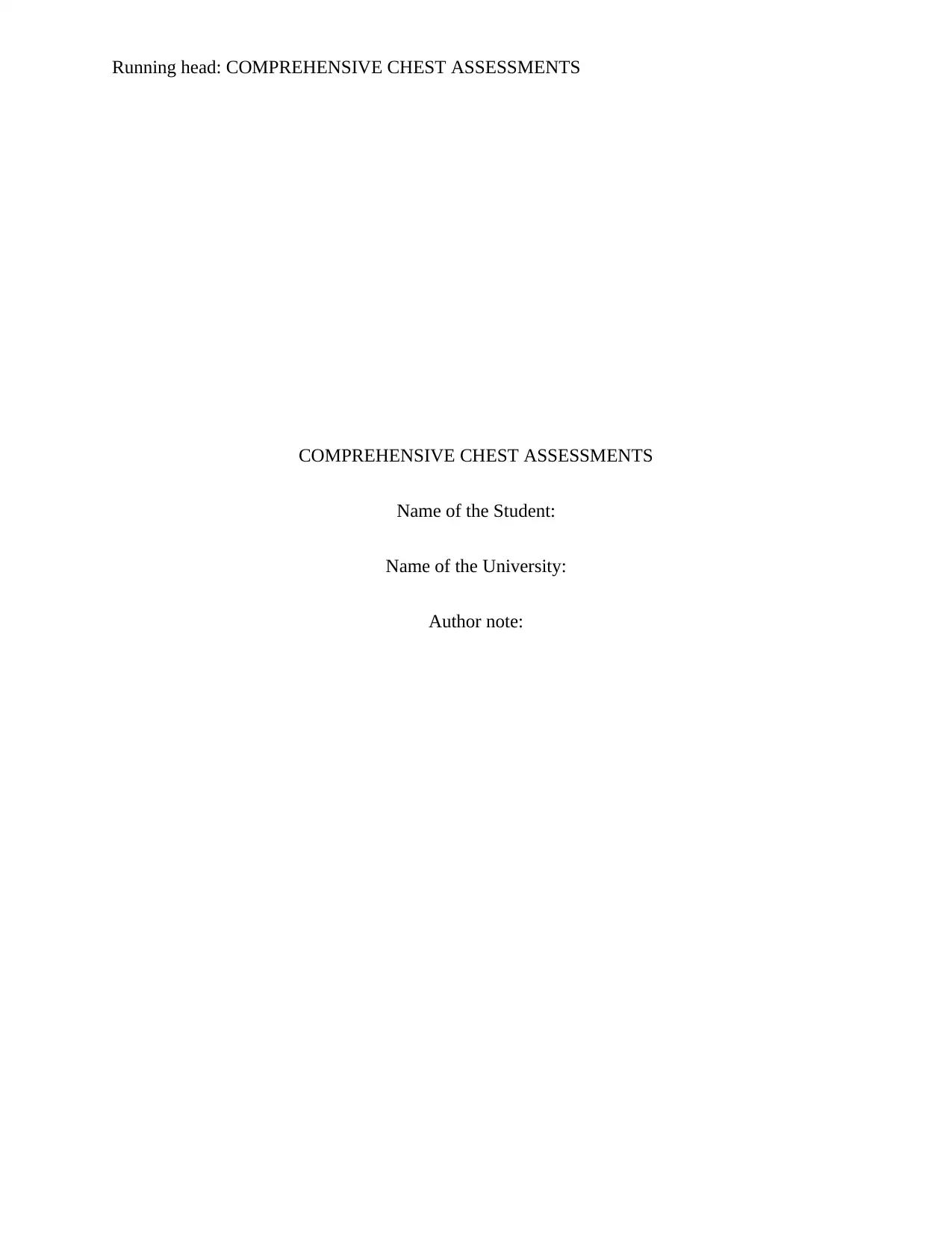
Running head: COMPREHENSIVE CHEST ASSESSMENTS
COMPREHENSIVE CHEST ASSESSMENTS
Name of the Student:
Name of the University:
Author note:
COMPREHENSIVE CHEST ASSESSMENTS
Name of the Student:
Name of the University:
Author note:
Paraphrase This Document
Need a fresh take? Get an instant paraphrase of this document with our AI Paraphraser
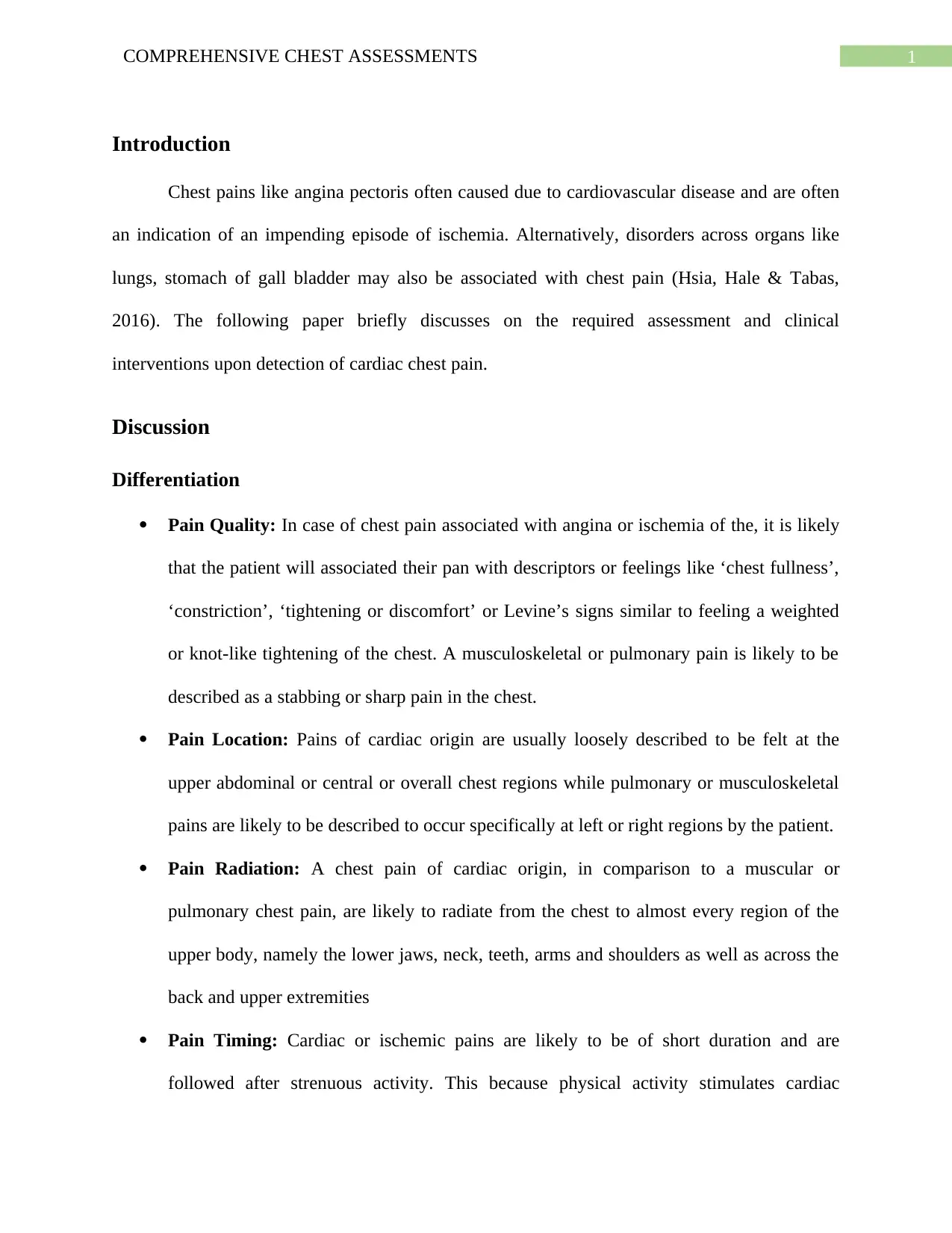
1COMPREHENSIVE CHEST ASSESSMENTS
Introduction
Chest pains like angina pectoris often caused due to cardiovascular disease and are often
an indication of an impending episode of ischemia. Alternatively, disorders across organs like
lungs, stomach of gall bladder may also be associated with chest pain (Hsia, Hale & Tabas,
2016). The following paper briefly discusses on the required assessment and clinical
interventions upon detection of cardiac chest pain.
Discussion
Differentiation
Pain Quality: In case of chest pain associated with angina or ischemia of the, it is likely
that the patient will associated their pan with descriptors or feelings like ‘chest fullness’,
‘constriction’, ‘tightening or discomfort’ or Levine’s signs similar to feeling a weighted
or knot-like tightening of the chest. A musculoskeletal or pulmonary pain is likely to be
described as a stabbing or sharp pain in the chest.
Pain Location: Pains of cardiac origin are usually loosely described to be felt at the
upper abdominal or central or overall chest regions while pulmonary or musculoskeletal
pains are likely to be described to occur specifically at left or right regions by the patient.
Pain Radiation: A chest pain of cardiac origin, in comparison to a muscular or
pulmonary chest pain, are likely to radiate from the chest to almost every region of the
upper body, namely the lower jaws, neck, teeth, arms and shoulders as well as across the
back and upper extremities
Pain Timing: Cardiac or ischemic pains are likely to be of short duration and are
followed after strenuous activity. This because physical activity stimulates cardiac
Introduction
Chest pains like angina pectoris often caused due to cardiovascular disease and are often
an indication of an impending episode of ischemia. Alternatively, disorders across organs like
lungs, stomach of gall bladder may also be associated with chest pain (Hsia, Hale & Tabas,
2016). The following paper briefly discusses on the required assessment and clinical
interventions upon detection of cardiac chest pain.
Discussion
Differentiation
Pain Quality: In case of chest pain associated with angina or ischemia of the, it is likely
that the patient will associated their pan with descriptors or feelings like ‘chest fullness’,
‘constriction’, ‘tightening or discomfort’ or Levine’s signs similar to feeling a weighted
or knot-like tightening of the chest. A musculoskeletal or pulmonary pain is likely to be
described as a stabbing or sharp pain in the chest.
Pain Location: Pains of cardiac origin are usually loosely described to be felt at the
upper abdominal or central or overall chest regions while pulmonary or musculoskeletal
pains are likely to be described to occur specifically at left or right regions by the patient.
Pain Radiation: A chest pain of cardiac origin, in comparison to a muscular or
pulmonary chest pain, are likely to radiate from the chest to almost every region of the
upper body, namely the lower jaws, neck, teeth, arms and shoulders as well as across the
back and upper extremities
Pain Timing: Cardiac or ischemic pains are likely to be of short duration and are
followed after strenuous activity. This because physical activity stimulates cardiac
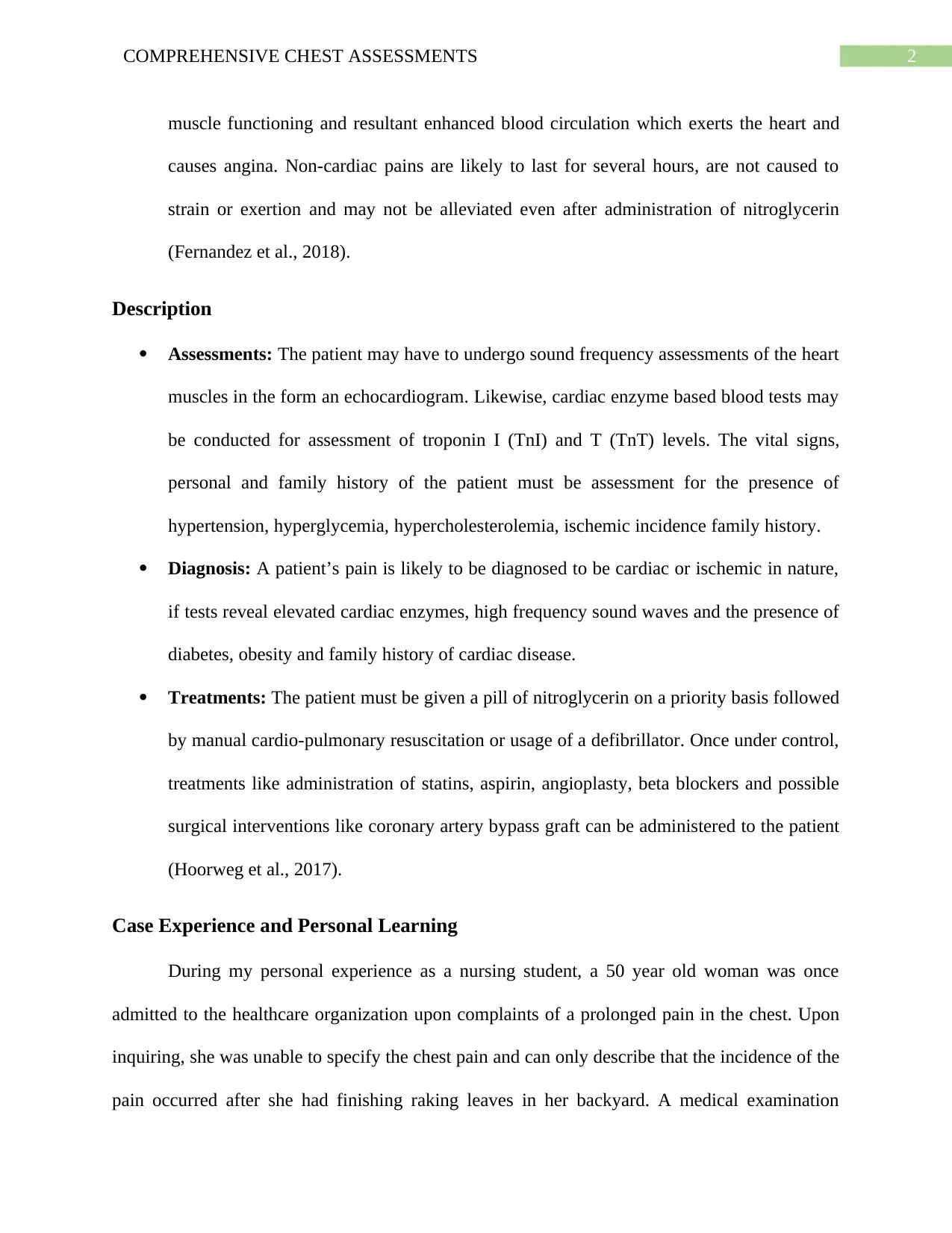
2COMPREHENSIVE CHEST ASSESSMENTS
muscle functioning and resultant enhanced blood circulation which exerts the heart and
causes angina. Non-cardiac pains are likely to last for several hours, are not caused to
strain or exertion and may not be alleviated even after administration of nitroglycerin
(Fernandez et al., 2018).
Description
Assessments: The patient may have to undergo sound frequency assessments of the heart
muscles in the form an echocardiogram. Likewise, cardiac enzyme based blood tests may
be conducted for assessment of troponin I (TnI) and T (TnT) levels. The vital signs,
personal and family history of the patient must be assessment for the presence of
hypertension, hyperglycemia, hypercholesterolemia, ischemic incidence family history.
Diagnosis: A patient’s pain is likely to be diagnosed to be cardiac or ischemic in nature,
if tests reveal elevated cardiac enzymes, high frequency sound waves and the presence of
diabetes, obesity and family history of cardiac disease.
Treatments: The patient must be given a pill of nitroglycerin on a priority basis followed
by manual cardio-pulmonary resuscitation or usage of a defibrillator. Once under control,
treatments like administration of statins, aspirin, angioplasty, beta blockers and possible
surgical interventions like coronary artery bypass graft can be administered to the patient
(Hoorweg et al., 2017).
Case Experience and Personal Learning
During my personal experience as a nursing student, a 50 year old woman was once
admitted to the healthcare organization upon complaints of a prolonged pain in the chest. Upon
inquiring, she was unable to specify the chest pain and can only describe that the incidence of the
pain occurred after she had finishing raking leaves in her backyard. A medical examination
muscle functioning and resultant enhanced blood circulation which exerts the heart and
causes angina. Non-cardiac pains are likely to last for several hours, are not caused to
strain or exertion and may not be alleviated even after administration of nitroglycerin
(Fernandez et al., 2018).
Description
Assessments: The patient may have to undergo sound frequency assessments of the heart
muscles in the form an echocardiogram. Likewise, cardiac enzyme based blood tests may
be conducted for assessment of troponin I (TnI) and T (TnT) levels. The vital signs,
personal and family history of the patient must be assessment for the presence of
hypertension, hyperglycemia, hypercholesterolemia, ischemic incidence family history.
Diagnosis: A patient’s pain is likely to be diagnosed to be cardiac or ischemic in nature,
if tests reveal elevated cardiac enzymes, high frequency sound waves and the presence of
diabetes, obesity and family history of cardiac disease.
Treatments: The patient must be given a pill of nitroglycerin on a priority basis followed
by manual cardio-pulmonary resuscitation or usage of a defibrillator. Once under control,
treatments like administration of statins, aspirin, angioplasty, beta blockers and possible
surgical interventions like coronary artery bypass graft can be administered to the patient
(Hoorweg et al., 2017).
Case Experience and Personal Learning
During my personal experience as a nursing student, a 50 year old woman was once
admitted to the healthcare organization upon complaints of a prolonged pain in the chest. Upon
inquiring, she was unable to specify the chest pain and can only describe that the incidence of the
pain occurred after she had finishing raking leaves in her backyard. A medical examination
⊘ This is a preview!⊘
Do you want full access?
Subscribe today to unlock all pages.

Trusted by 1+ million students worldwide
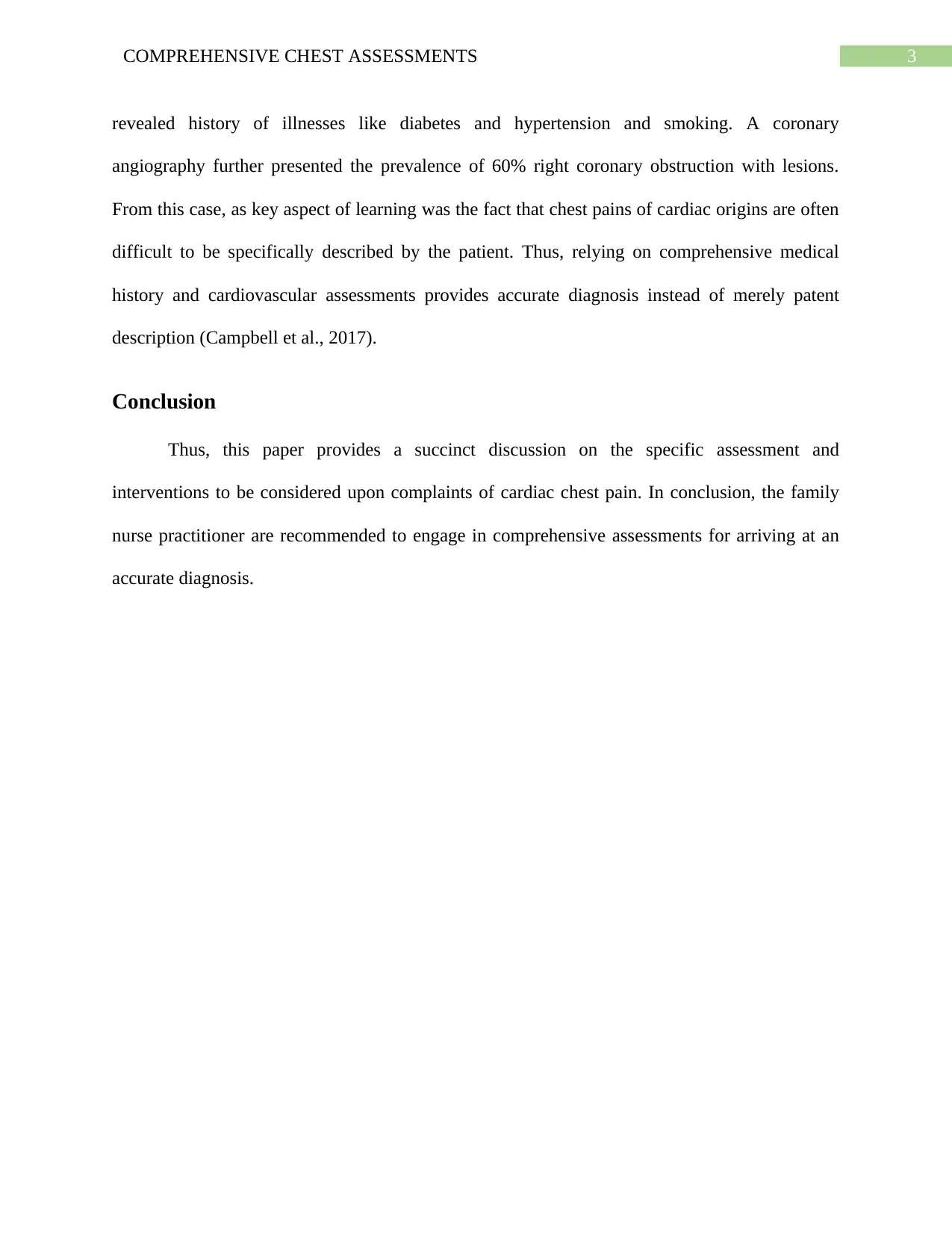
3COMPREHENSIVE CHEST ASSESSMENTS
revealed history of illnesses like diabetes and hypertension and smoking. A coronary
angiography further presented the prevalence of 60% right coronary obstruction with lesions.
From this case, as key aspect of learning was the fact that chest pains of cardiac origins are often
difficult to be specifically described by the patient. Thus, relying on comprehensive medical
history and cardiovascular assessments provides accurate diagnosis instead of merely patent
description (Campbell et al., 2017).
Conclusion
Thus, this paper provides a succinct discussion on the specific assessment and
interventions to be considered upon complaints of cardiac chest pain. In conclusion, the family
nurse practitioner are recommended to engage in comprehensive assessments for arriving at an
accurate diagnosis.
revealed history of illnesses like diabetes and hypertension and smoking. A coronary
angiography further presented the prevalence of 60% right coronary obstruction with lesions.
From this case, as key aspect of learning was the fact that chest pains of cardiac origins are often
difficult to be specifically described by the patient. Thus, relying on comprehensive medical
history and cardiovascular assessments provides accurate diagnosis instead of merely patent
description (Campbell et al., 2017).
Conclusion
Thus, this paper provides a succinct discussion on the specific assessment and
interventions to be considered upon complaints of cardiac chest pain. In conclusion, the family
nurse practitioner are recommended to engage in comprehensive assessments for arriving at an
accurate diagnosis.
Paraphrase This Document
Need a fresh take? Get an instant paraphrase of this document with our AI Paraphraser
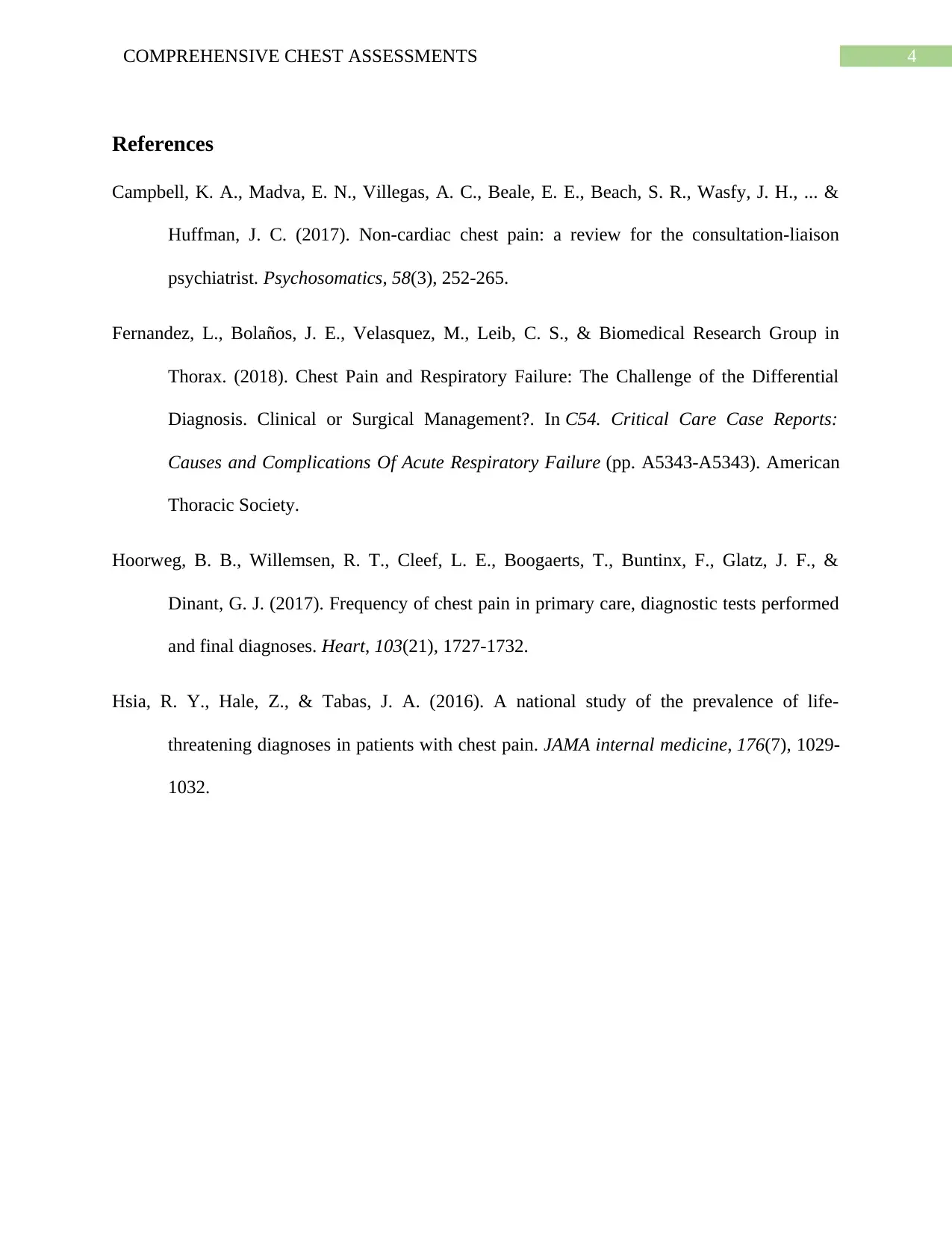
4COMPREHENSIVE CHEST ASSESSMENTS
References
Campbell, K. A., Madva, E. N., Villegas, A. C., Beale, E. E., Beach, S. R., Wasfy, J. H., ... &
Huffman, J. C. (2017). Non-cardiac chest pain: a review for the consultation-liaison
psychiatrist. Psychosomatics, 58(3), 252-265.
Fernandez, L., Bolaños, J. E., Velasquez, M., Leib, C. S., & Biomedical Research Group in
Thorax. (2018). Chest Pain and Respiratory Failure: The Challenge of the Differential
Diagnosis. Clinical or Surgical Management?. In C54. Critical Care Case Reports:
Causes and Complications Of Acute Respiratory Failure (pp. A5343-A5343). American
Thoracic Society.
Hoorweg, B. B., Willemsen, R. T., Cleef, L. E., Boogaerts, T., Buntinx, F., Glatz, J. F., &
Dinant, G. J. (2017). Frequency of chest pain in primary care, diagnostic tests performed
and final diagnoses. Heart, 103(21), 1727-1732.
Hsia, R. Y., Hale, Z., & Tabas, J. A. (2016). A national study of the prevalence of life-
threatening diagnoses in patients with chest pain. JAMA internal medicine, 176(7), 1029-
1032.
References
Campbell, K. A., Madva, E. N., Villegas, A. C., Beale, E. E., Beach, S. R., Wasfy, J. H., ... &
Huffman, J. C. (2017). Non-cardiac chest pain: a review for the consultation-liaison
psychiatrist. Psychosomatics, 58(3), 252-265.
Fernandez, L., Bolaños, J. E., Velasquez, M., Leib, C. S., & Biomedical Research Group in
Thorax. (2018). Chest Pain and Respiratory Failure: The Challenge of the Differential
Diagnosis. Clinical or Surgical Management?. In C54. Critical Care Case Reports:
Causes and Complications Of Acute Respiratory Failure (pp. A5343-A5343). American
Thoracic Society.
Hoorweg, B. B., Willemsen, R. T., Cleef, L. E., Boogaerts, T., Buntinx, F., Glatz, J. F., &
Dinant, G. J. (2017). Frequency of chest pain in primary care, diagnostic tests performed
and final diagnoses. Heart, 103(21), 1727-1732.
Hsia, R. Y., Hale, Z., & Tabas, J. A. (2016). A national study of the prevalence of life-
threatening diagnoses in patients with chest pain. JAMA internal medicine, 176(7), 1029-
1032.
1 out of 5
Related Documents
Your All-in-One AI-Powered Toolkit for Academic Success.
+13062052269
info@desklib.com
Available 24*7 on WhatsApp / Email
![[object Object]](/_next/static/media/star-bottom.7253800d.svg)
Unlock your academic potential
Copyright © 2020–2025 A2Z Services. All Rights Reserved. Developed and managed by ZUCOL.





